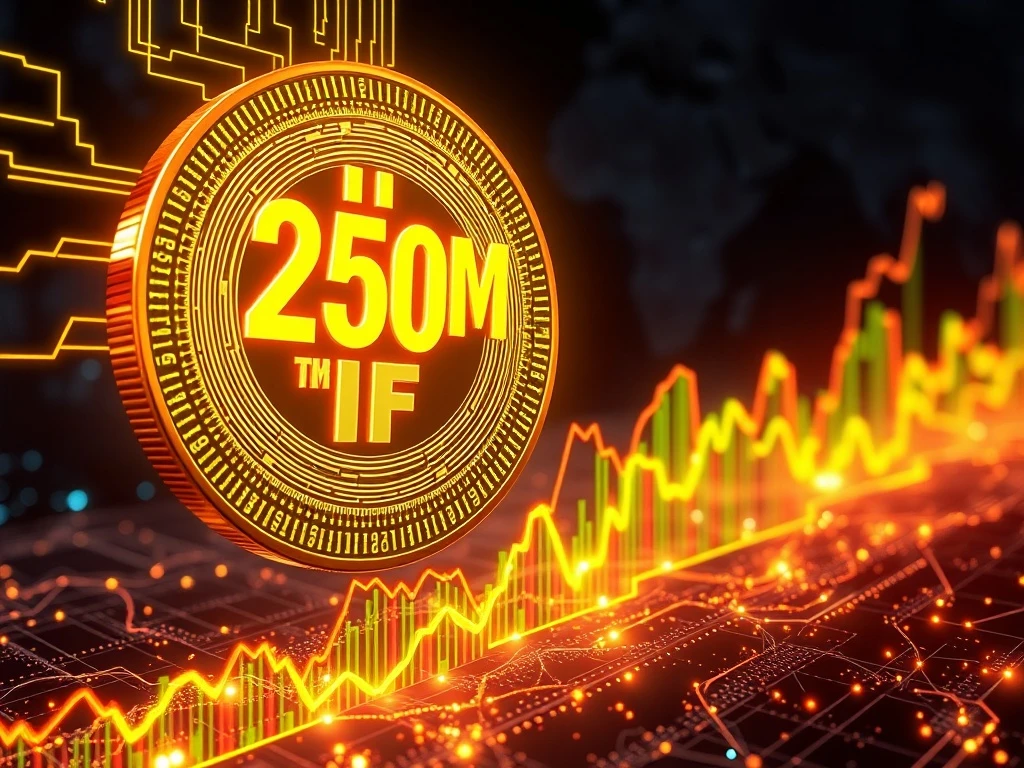USDC Minting: Unlocking Massive Liquidity for Crypto Markets

The cryptocurrency world is buzzing, and a recent event has captured significant attention: the massive 250 million USDC minting. This isn’t just a number; it’s a powerful indicator of the growing role stablecoins play in bridging traditional finance with the dynamic decentralized ecosystem. For anyone tracking crypto markets, understanding this surge in stablecoin demand is crucial, as it often signals significant shifts in capital flows and market sentiment.
What is USDC Minting and Why Does it Matter?
USDC, or USD Coin, is a stablecoin pegged 1:1 to the U.S. dollar. It’s a cornerstone of the crypto economy, offering stability in a volatile market. The process of USDC minting involves converting fiat currency deposits into digital USDC tokens. This process is managed by the Centre Consortium, a collaboration between Circle and Coinbase, ensuring that each USDC token is backed by audited reserves. When 250 million USDC are minted, it signifies a substantial influx of new capital ready to flow into the crypto space.
This event is more than just an accounting entry; it reflects a tangible increase in demand for stable liquidity across various facets of the crypto market. Whether it’s for trading, engaging with DeFi protocols, or facilitating cross-border transactions, USDC provides a reliable medium. Such large-scale issuance events are closely watched by analysts and investors alike because they can often precede significant movements in major cryptocurrencies like Bitcoin and Ethereum, or boost activity within decentralized finance.
Why the Surge in Stablecoin Demand?
The recent stablecoin demand surge, highlighted by the 250 million USDC mint, points to several key trends within the crypto ecosystem. Stablecoins serve as crucial on-ramps and off-ramps for investors, allowing them to enter or exit volatile assets without needing to convert back to traditional fiat currency. Here are some primary drivers:
Trading Efficiency: Traders use stablecoins to quickly move between different cryptocurrencies, locking in gains or minimizing losses without incurring multiple fiat conversion fees or delays.
DeFi Participation: Stablecoins are the lifeblood of decentralized finance (DeFi), enabling users to participate in lending, borrowing, yield farming, and liquidity provision with reduced price volatility risk.
Cross-Border Transactions: USDC offers a fast, low-cost alternative for international remittances and payments, bypassing traditional banking bottlenecks.
Institutional Interest: Growing institutional adoption of crypto often begins with stablecoins, as they provide a familiar, regulated entry point into the digital asset space.
This increased demand signals a maturing market where participants seek both opportunity and stability, making stablecoins an indispensable tool.
How Does This Impact Crypto Liquidity?
A 250 million USDC injection has direct implications for crypto liquidity. Liquidity refers to the ease with which an asset can be converted into cash without affecting its market price. When a significant amount of stablecoin enters the market, it typically:
Bolsters Exchange Liquidity: More USDC on exchanges means deeper order books, making it easier for large trades to execute without causing significant price slippage.
Tightens Trading Spreads: Increased liquidity often leads to narrower bid-ask spreads, making trading more efficient and less costly for participants.
Enhances DeFi Activities: A larger supply of stablecoins can be deployed into lending protocols, decentralized exchanges (DEXs), and yield-generating platforms, increasing the Total Value Locked (TVL) and potentially offering better rates for borrowers and lenders.
The ultimate impact, however, hinges on how this newly minted capital is utilized. Will it flow directly into Bitcoin or Ethereum, driving up prices, or will it remain within stablecoin treasuries, ready for future deployment? Whale Alert’s tracking provides valuable transparency, but the subsequent movement of these funds is what truly shapes market dynamics.
DeFi Growth and the Role of Stablecoins
The relationship between stablecoins and DeFi growth is symbiotic. Stablecoins provide the necessary stability for DeFi protocols to function effectively. Without them, the inherent volatility of cryptocurrencies would make lending, borrowing, and yield farming far too risky for most participants. The 250 million USDC mint directly contributes to the capital available within the DeFi ecosystem.
Consider the following aspects of how stablecoins fuel DeFi:
Lending and Borrowing: Users can lend out USDC to earn interest or borrow against their crypto collateral using USDC, creating a robust credit market.
Yield Farming: Participants can provide USDC to liquidity pools on DEXs or engage in yield farming strategies, earning rewards from transaction fees or governance tokens.
Stable Swaps: Stablecoin pools on DEXs like Curve Finance allow for efficient, low-slippage swaps between different stablecoins, further enhancing liquidity and utility.
The continuous influx of stablecoins like USDC is vital for the health and expansion of the DeFi sector, enabling more complex financial products and increasing accessibility for a broader user base.
Assessing the Market Impact: Opportunities and Risks
The immediate market impact of a large USDC mint is often seen as a bullish signal, indicating fresh capital entering the crypto space. It suggests growing confidence from both institutional and retail investors. Consistent large-scale mints during bullish trends can reinforce this sentiment, hinting at sustained growth potential.
However, it’s crucial for market participants to assess both the opportunities and the inherent risks:
| Opportunities | Risks & Considerations |
|---|---|
| Increased trading opportunities | Centralization concerns for stablecoins |
| Potentially higher DeFi yields | Intensifying regulatory scrutiny globally |
| Enhanced market stability | How capital is utilized (dormant vs. deployed) |
| Sign of growing confidence & adoption | Potential for market manipulation (less likely with USDC’s backing) |
While USDC’s reserve-backed model and regular audits underpin its reliability, the centralized nature of its issuance and the increasing regulatory scrutiny worldwide remain key considerations. Investors should monitor how such capital influxes might reshape lending rates, influence asset allocations, and potentially impact overall market volatility. USDC’s role as a stable intermediary is well-established, but its expanding influence demands careful consideration of both the potential upside and the challenges ahead.
Conclusion: Navigating the Evolving Stablecoin Landscape
The 250 million USDC minting event is a powerful reminder of stablecoins’ indispensable and growing role in the cryptocurrency market. It underscores the robust demand for stable liquidity, fueling everything from day-to-day trading to the intricate mechanisms of decentralized finance. While it generally signals positive capital inflows and enhanced market efficiency, it also brings into focus the ongoing debates around centralization and the evolving regulatory landscape. For investors and enthusiasts alike, understanding these dynamics is key to navigating the opportunities and challenges in this ever-evolving digital financial frontier. As stablecoins continue to bridge the gap between traditional finance and the decentralized world, their influence will only grow, making their movements a critical metric for any serious crypto observer.
Frequently Asked Questions (FAQs)
Q1: What does a USDC minting event mean for the crypto market?
A USDC minting event signifies that new U.S. dollar deposits have been converted into USDC tokens. This typically indicates an increase in demand for stablecoin liquidity, which can be a bullish signal for the broader crypto market as it suggests fresh capital is entering the ecosystem, ready to be deployed into various assets or DeFi protocols.
Q2: Is USDC fully backed by U.S. dollars?
Yes, USDC is designed to be fully backed 1:1 by U.S. dollar reserves and highly liquid assets. The Centre Consortium, which governs USDC, regularly publishes attestations by independent accounting firms to verify these reserves, aiming to ensure transparency and trust in its backing.
Q3: How does stablecoin demand affect DeFi?
Increased stablecoin demand directly fuels DeFi growth. Stablecoins provide the necessary stability for lending, borrowing, yield farming, and liquidity provision protocols. More stablecoins in circulation mean more capital available to be locked into DeFi, potentially leading to higher yields for liquidity providers and greater efficiency for borrowers.
Q4: Are there any risks associated with large USDC mints?
While large USDC mints generally indicate positive capital inflows, some risks include potential centralization concerns given that USDC is issued by a consortium. Additionally, regulatory scrutiny on stablecoins is intensifying globally, which could impact their operations. The ultimate market impact also depends on how the minted capital is utilized—whether it actively flows into volatile assets or remains dormant.
Q5: How can I track USDC minting events?
Services like Whale Alert often track and report large USDC minting events as they happen. Additionally, you can monitor the official transparency reports from Circle (one of the co-founders of Centre Consortium) or track the USDC supply on blockchain explorers.









